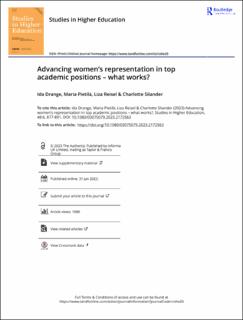| dc.contributor.author | Drange, Ida | |
| dc.contributor.author | Pietilä, Maria | |
| dc.contributor.author | Reisel, Liza | |
| dc.contributor.author | Silander, Charlotte | |
| dc.date.accessioned | 2023-10-19T06:01:36Z | |
| dc.date.available | 2023-10-19T06:01:36Z | |
| dc.date.created | 2023-02-26T15:57:18Z | |
| dc.date.issued | 2023 | |
| dc.identifier.citation | Studies in Higher Education. 2023, . | en_US |
| dc.identifier.issn | 0307-5079 | |
| dc.identifier.uri | https://hdl.handle.net/11250/3097390 | |
| dc.description.abstract | Which gender equality measures do Nordic universities use, and to what
extent are the measures effective in increasing the share of women in top
academic positions? Based on theories that distinguish between actor and
structure-oriented measures, and between strategies of inclusion and
transformation, we identified four types of measures: career enhancing
measures offered for women, training and awareness-raising measures,
organizational responsibility measures and preferential treatment
measures. We investigated the use and efficacy of the four types of
policy measures in 37 universities in Sweden, Norway and Finland,
implemented between 1995 and 2018. The policy data was collected
through on structured interviews with universities’ HR staff and equality
officers. By combining these unique survey data and register data on
universities’ teaching and research staff we assess the impact of
institutional gender equality policy on the gender composition of
academics in grade A positions. We find strong growth in the use of
organizational responsibility and awareness-raising measures over time,
and weaker use of career enhancing measures and preferential
treatment. Overall, the institutional measures have a limited effect on
the growth in the share of women in grade A positions. Nonetheless,
we find that the implementation of structural measures is associated
with the growth of women in grade A positions. | en_US |
| dc.language.iso | eng | en_US |
| dc.rights | Attribution-NonCommercial-NoDerivatives 4.0 Internasjonal | * |
| dc.rights.uri | http://creativecommons.org/licenses/by-nc-nd/4.0/deed.no | * |
| dc.title | Advancing women’s representation in top academic positions–what works? | en_US |
| dc.type | Peer reviewed | en_US |
| dc.type | Journal article | en_US |
| dc.description.version | publishedVersion | en_US |
| cristin.ispublished | true | |
| cristin.fulltext | original | |
| cristin.qualitycode | 2 | |
| dc.identifier.doi | 10.1080/03075079.2023.2172563 | |
| dc.identifier.cristin | 2129376 | |
| dc.source.journal | Studies in Higher Education | en_US |
| dc.source.pagenumber | 0 | en_US |

